Obituary
The Times
February 2nd 2001
courtesy and copyright of The Times
http://thetimes.co.uk
Walter Hayes
Ford executive who brought Formula One car making to Britain
One segment of the British motor industry is globally dominant today, and Walter Hayes could claim much of the credit. The multimillion-pound business of building Formula One racing cars tales place predominantly in England because as a Ford executive he decided to invest £100,000 in a new engine, designed and built in Northampton, arguing that it would bring both the company and Britain prestige.
The engine was so successful that it became the power plant of choice for the great majority of teams through the 1970s and 1980s, winning more than 150 grands prix.
Being the source of these engines – and the home of much technical expertise spun off from the Ford-powered world championship teams of Lotus and Tyrrell – made Britain the preferred place to build Formula One cars.
Hayes, who was eventually invited back from retirement to become chairman of Aston Martin, had begun his career as a journalist. He became Editor of the Sunday Dispatch in 1956 with a brief to move it upmarket.
Among contributors he signed up were a young designer called Terence Conran to report on style and, as motoring correspondent, a young car engineer called ColIn Chapman. However, he gave up the serialising of racy books of the day, such as Forever Amber, and without these the paper lost readers. Hayes rejoined the Daily Mail as associate editor in 1959.
By this time British Ford was in difficulties on two fronts. The workforce was restless, and the company’s vehicles, while profitable, lacked flair. This failure to excite the public became all the more clear when the Mini was launched by the British Motor Corporation, and became the classless symbol of a new type of motoring. Ford’s British chairman, Sir Patrick Hennessy, wanted someone with press experience to help the company with its internal and external communications, and Hayes was duly lured.
Around him he gathered journalists he had known from Fleet Street from the Daily Mail and The Times, and under his direction they produced a flow of news which kept Ford in the headlines for reasons other than its strikes.
He also kept up a flow of ideas for promoting new models. For instance, two Ford dealers drove a Ford Corsair from Cape Town to Southampton in a race against an ocean liner. They won, but only just. Then he sent them to drive around the world.
Increasingly, though, he saw success in international motorsport as the way to give Ford’s products a boost. By now Colin Chapman was one of the dominant figures in this field, and his modifications to a Ford Cortina gave Hayes a car recognisably like the ones on the road but capable of winning on the racetrack and in international rallies.
Jim Clark drove the Lotus Cortina in circuit races as nobody else could (sometimes on two wheels), and when the Ford Formula One Cosworth engine was fitted into Chapman’s new Lotus, Clark won the 1967 Dutch Grand Prix on its first outing. After Clark’s death, Jackie Stewart won 25 world championship races for Ford, mainly driving a Tyrrell-Ford.
Ford also competed across the range of motorsports, from rallying, in which the Ford Escort became dominant, to Formula Ford (set up to give enthusiasts a cheap entry into single-seater racing). A variant of the grand prix engine proved almost equally successful in American circuit racing.
In the late 1960s, Ford battled against Ferrari at Le Mans, with the Ford GT40 – built especially for the purpose with Hayes’s enthusiastic backing- winning convincing victories over the Italians.
Hayes’s counsel was sought not just on motorsport, but on the whole range of the company’s activities internationally. He developed a rapport with Henry Ford II, accompanying him on many European trips and writing his autobiography, Henry.
He published an eclectic collection of titles, which also included a book of verse, a study of the crew of the Bounty after the Mutiny and a children’s book, Angelica, which he claimed he wrote while waiting to be called into a board meeting in Detroit. After various, top executive posts with European and finally worldwide responsibilities he retired at 65, but was promptly brought back to look after the ailing but prestigious Aston Martin brand, which Ford was buying. Ford had previously shown interest in purchasing British Leyland and Jaguar, but had been thwarted by political resistance to American ownership.
Hayes laid the foundations for the company’s renaissance, and with his guidance the Aston Martin DB7 became the bestselling car in its history. Moreover, the way that Ford, in the person of Hayes, conducted the Aston Martin takeover almost certainly smoothed the path for Ford’s acquisition of Jaguar when the time came.
Walter Hayes was appointed CBE in 1980.
He and his wife Elizabeth recently celebrated their golden wedding. She survives him, along with two sons and a daughter.
